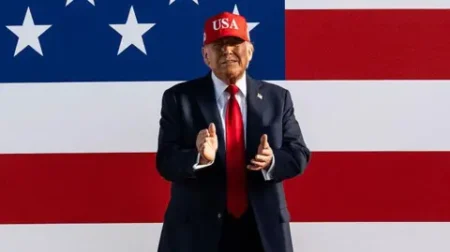The recent developments surrounding President Donald Trump’s tariff policies are creating significant ripples in the business landscape across Asia. As outlined by Suranjana Tewari, an Asia Business Correspondent based in Singapore, the repercussions of these tariffs are being deeply felt by industries that rely heavily on Asian supply chains. Companies like GlobalFoundries, for instance, are facing the reality of rapidly shifting trade regulations, which threaten not only their operational stability but also their long-term strategic planning.
Tan Yew Kong, who oversees operations for GlobalFoundries, likens his company to a tailor’s shop that customizes semiconductor chips according to client specifications. However, the unpredictable nature of Trump’s tariff announcements dampens their ability to plan effectively. The 90-day pause on steep tariffs, which is set to end on July 9, leaves businesses in limbo, raising questions about how they should respond as Trump threatens to impose substantial tariffs—ranging from 10% to 70%—on unspecified nations. Although semiconductors currently remain exempt, this situation is fraught with uncertainty, making it challenging for companies to prepare for future demands.
Beyond the semiconductor industry, the ramifications of these tariffs extend to a myriad of sectors, including textiles, automotive manufacturing, and various consumer goods. For instance, when Trump originally announced tariffs in April, countries like Japan, South Korea, and Vietnam faced steep tariffs, signaling a shift in the trade dynamics among longstanding allies. Malaysia’s Prime Minister has specifically noted the adverse effects these tariffs would have on several industries, setting the stage for potentially significant economic fallout.
The geopolitical landscape is further confused by negotiation attempts from countries hoping to mitigate the impact of the tariffs. Japan and South Korea have engaged in trade discussions during the tariff reprieve, while Vietnam has struck a deal allowing for a distinct reduction in levies on its exports. However, not all nations are already able to shore up favorable terms, as poorer countries like Cambodia face staggering tariffs upwards of 49%, which could severely hamper their economic validity in the international market.
The complexities escalate as businesses diversify supply chains due to volatility and trade restrictions. This “China + 1” strategy, where firms seek to set up operations in other Asian countries beside China, reflects a significant shift in global trade networks aimed at ensuring continued access to critical markets, such as the United States. The uncertainty looms larger as companies are exploring options to bolster inventories and extend lead times to counterbalance the disruptions.
Moving further afield, industries are also experiencing profound shifts in investment patterns. Due to the tariff-induced increases in operational costs, brands like Nike are feeling compelled to pass on these costs to consumers, ultimately impacting their competitiveness. This has led to various companies looking to regions like the Philippines or Singapore, where tariffs are lower, to cement their manufacturing bases.
Interestingly, while the US continues to impose tariffs that complicate business for American firms operating abroad, Asia appears to be moving in the opposite direction, embracing trade openness. Countries with considerable domestic demands, such as India, might find a buffer against the flux, but nations with more export-oriented economies like Singapore and Vietnam remain vulnerable.
As Trump’s policies encourage a rethink of strategic business pathways in Asia, many experts suggest that this instigates the emergence of a new world order in global trade. The balance of economic power may sway differently, as nations reevaluate their alliances and trade frameworks in the face of increased protectionist sentiments from the US. The tumultuous nature of these developments posits a critical juncture for Asian businesses, prompting a cautious analysis of future relations, investments, and trade agreements.
In conclusion, as these tariff policies reshape how companies operate, renavigate supply chains, and seek alternative markets, they also propel a broader conversation about the future of global trade. The need for flexibility amid unpredictability has never been more paramount, indicating that the economic landscape may be on the brink of transformative changes, with the potential to recalibrate longstanding trade paradigms. As the old proverb suggests, one must “Bow to the ruler, and then go your own way,” underscoring the delicate balancing act that companies must now adopt in navigating these choppy waters of international commerce.











